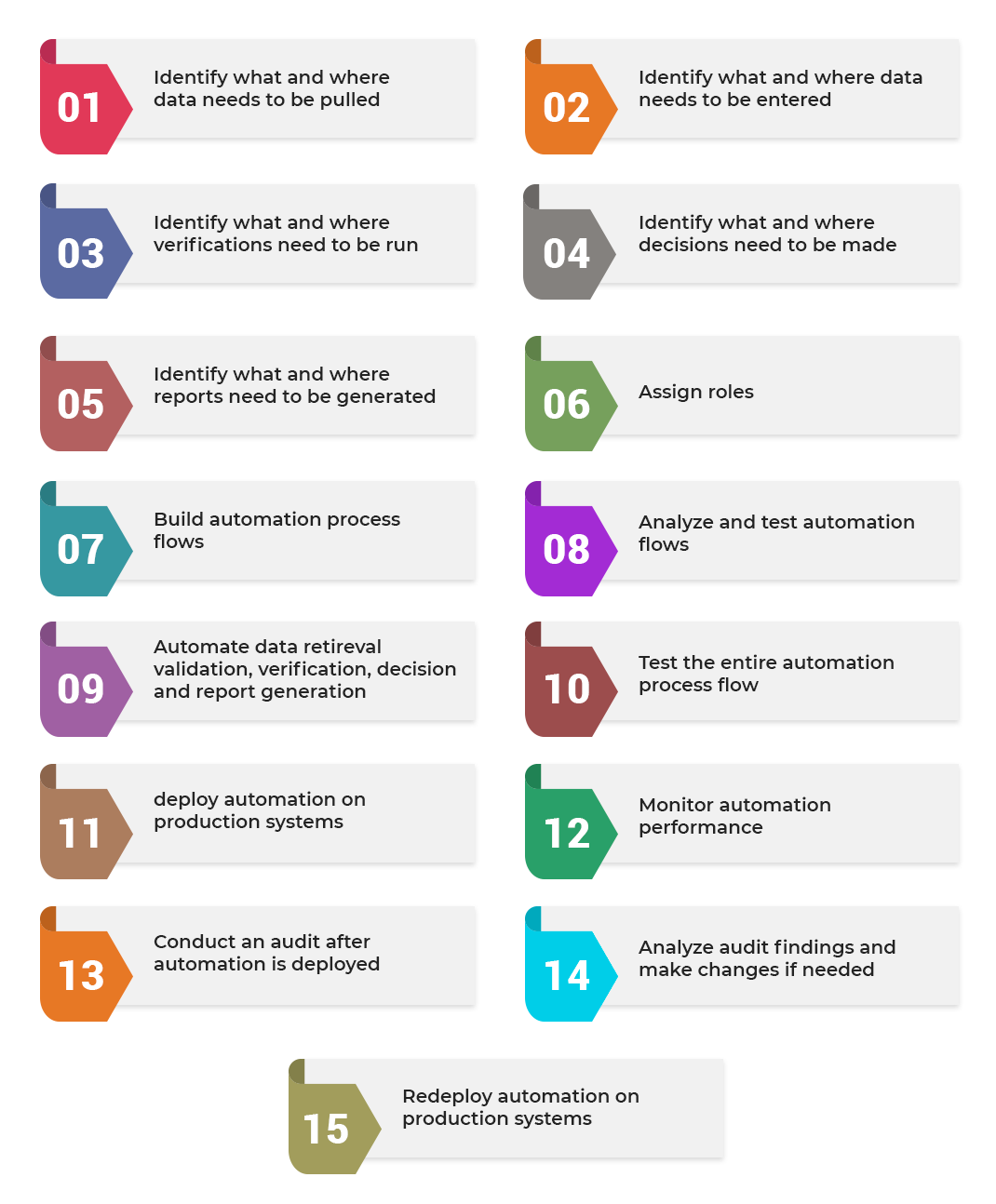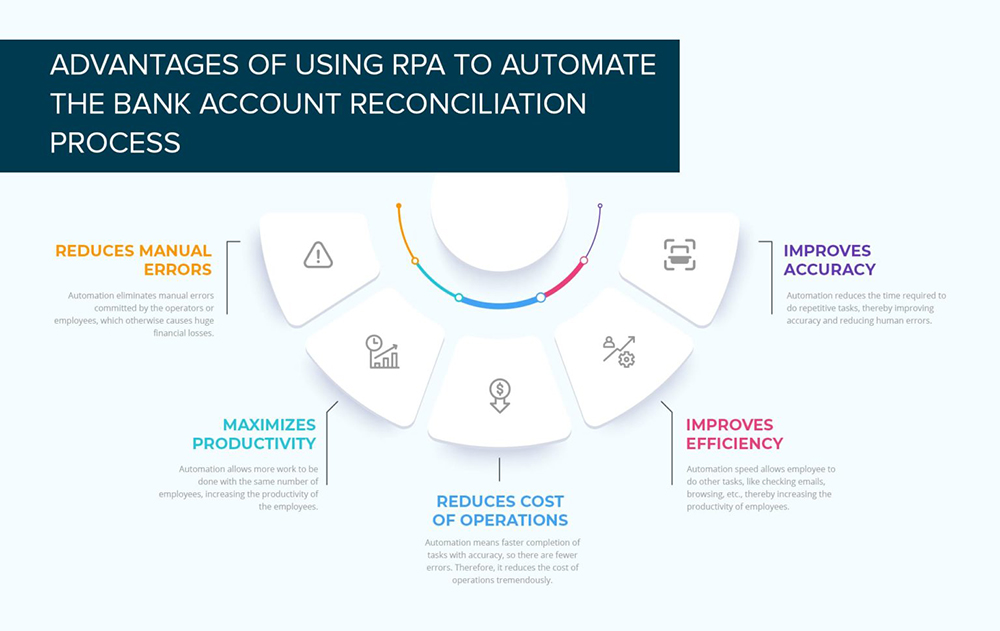
Learn, how our robots revolutionize processes and skyrocket ROI across industries.
A bank reconciliation process is a procedure used to ensure that the cash balance in a company's accounting records matches the corresponding balance on their bank statement. This process involves comparing the transactions recorded in the company's accounting system to the transactions listed on their bank statement and identifying any discrepancies.
Automating this process using RPA (Robotic Process Automation) can help to improve efficiency, reduce errors, and save time. RPA software can automate the task of collecting and organizing data from various sources, such as bank statements, accounting records, and other financial systems. This can help to streamline the reconciliation process and make it more accurate, as the software can quickly identify and flag any discrepancies for further investigation. Additionally, RPA can also help to automate the task of creating and updating financial reports, which can help to improve the overall accuracy and timeliness of the company's financial information.

Using RPA (Robotic Process Automation) can help to simplify and improve the bank reconciliation process by automating repetitive and error-prone tasks. The technology can minimize human error, increase efficiency and scalability by automating the steps involved in the process.
In today's business landscape, automation has become a necessity. Robotic Process Automation (RPA) assists companies in streamlining repetitive and complex business processes by using virtual robots to perform tasks such as data entry and processing. Many organizations have adopted paperless accounting and have turned to RPA to automate accounting functions like Accounts Payable, Accounts Receivable, and Bank Reconciliation. RPA helps identify errors and
inefficiencies in current processes, making them more efficient and accurate. Reconciliation, the process of matching bank statements with accounting records, can be a tedious and error-prone task for larger companies. RPA can simplify this process by automating data collection and analysis, and providing an accurate and efficient platform for reconciliation. RPA also ensures compliance with regulatory requirements and provides audit trails for transparency.
RPA (Robotic Process Automation) tools can automate various tasks related to bank reconciliation such as logging into accounts, capturing, and processing transactions, fetching data from shared folders and reconciling accounts. These tools use bots to simulate human actions and automate repetitive tasks.
The use of RPA tools is becoming increasingly popular in the banking industry as they can be used to automate processes such as loan approval, investment banking, compliance with regulations, anti-money laundering and reconciliation. In addition, RPA tools can also perform operations such as currency conversion, credit transfer, and payment processing. By automating end-to-end processes, banks can improve their efficiency and reduce the risk of manual errors.
Bank Reconciliation is a process of comparing the transactions recorded in a company's accounting system with the transactions listed on their bank statement, to ensure that the cash balance matches. With RPA (Robotic Process Automation), the entire process of bank reconciliation can be automated in a step-by-step manner, reducing human errors and minimizing the time spent on the process. RPA can automate repetitive tasks and improve efficiency, which has resulted in an 80% reduction in the time required for bank reconciliation. The process of automating bank reconciliation using RPA typically involves the following steps:

Reconciling bank accounts and financial data is an essential task for businesses of all sizes. Automating this process using an RPA solution can bring significant benefits in terms of efficiency, accuracy, and cost savings.
Our RPA solution provides a centralized tool for reconciling banking data, streamlining the process, and reducing risk. The technology can be deployed across multiple locations and ERP systems, allowing for a unified payments platform across different sites and banks.
The solution automatically reconciles General Ledger and Bank Statement items and allows for unreconciled items to be carried over to future reconciliations. The software also provides a clear display of unreconciled items and amounts.
Properly reconciling transactions is crucial for maintaining accurate and up-to-date accounting records. Although computerized accounting software can make the process relatively easy, there are still several steps that should be followed to ensure accuracy. The Bank Reconciliation report allows for checking accounts to be compared to bank statements and should ideally be performed on a daily basis or as agreed upon with the financial institution.
The figure above illustrates the pipeline of the bank reconciliation process, which can be segmented into four main sub-modules: document data extraction, matching, reconciliation, and finalization.

The first step in the process is document data extraction. Bank statements can come in various forms, such as printed documents or digital PDFs, which makes manual data collection highly tedious and prone to errors. RPA (Robotic Process Automation) automates this process by scanning the documents and extracting important information, such as names and account numbers, from the document.
Once data has been extracted, it needs to be matched with records in other systems, such as the core banking system. The matching module in the reconciliation process compares data in documents with records in other databases.
The next step is the reconciliation of data. The reconciliation module performs data analysis, extracting matching data and then merging it with data from other sources. This ensures that all the data captured in the reconciliation process is correct. Any errors will be reported for fixing and reviewed for final approvals. This stage is very labor-intensive as errors require follow-ups, reminders, and feedback to proceed. These are handled by workflow automation.
Finally, the last step in the process is the finalization of data. This step involves checking accuracy, removing incorrect data, and cleaning up data.
Overall, the reconciliation process involves multiple phases and tasks, so it's important to select and incorporate optimized workflows to ensure the process runs smoothly. Factors such as minimizing human error, increasing efficiency and scalability must be considered while incorporating RPA.
Reconciliation is the process of verifying the accuracy of records by comparing them to related documents. In large companies, this process often involves a large number of documents. By using bots for reconciliation, all necessary documents can be efficiently collected, organized in a structured manner, and easily accessed for future reference.
It is crucial for a company to determine the source of an error, whether it is from within the company or from the bank. In rare cases, errors may be caused by external breaches, so it's important to investigate. By using RPA bots to automate the reconciliation process, it can provide traceability and the ability to quickly correct errors by auditing each step of the process.
When a company is small and has a limited number of income sources, it is relatively easy to compare data. However, when a large volume of transactions occur in a complex relationship with other data, and time is limited for employees, it becomes more likely that some transactions may be overlooked or simplified. This can be a significant problem as errors in these transactions can have high stakes. Automating the process with RPA ensures that all transactions are handled effectively and efficiently, reducing the chance of errors and increasing accuracy.
"Our system is designed to integrate seamlessly with ERP and other accounting software such as Quickbooks and Tally, making it a valuable tool for organizations looking to streamline and manage their core processes."
"Our system offers both pre-set and tailored key performance indicators (KPIs) for monitoring cash flow and ensuring compliance. It is crucial for organizations to have transparent cash flow records for auditing, financial planning, and business operations. With accurate reconciliation, these records can also serve as a valuable resource for future financial planning."
When implementing an automated bank reconciliation system, it is essential to take both efficiency and ethical considerations into account. It is important to thoroughly review the system across all relevant departments to ensure that it meets the necessary standards. Additionally, to ensure optimal efficiency, it is crucial to ensure that the system not only improves accuracy compared to traditional methods, but also keeps costs at a similar level.
In today's business landscape, it is essential for companies to keep their transaction costs as low as possible in order to maintain profitability. One way to achieve this is by implementing Robotic Process Automation (RPA) to automate certain manual processes, such as bank reconciliation.
By using RPA to automate these tasks, companies can reduce operational costs and free up employees' time for more important tasks. Additionally, RPA helps to eliminate errors, increase efficiency and accuracy, and maximize productivity. This not only reduces the operational costs of banks, but also reduces the amount of time your employees spend on these reconciliations.


Schedule A Meeting with us